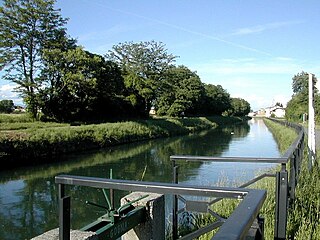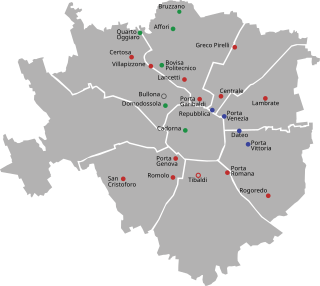
Canals or artificial waterways are waterways or engineered channels built for drainage management or for conveyancing water transport vehicles. They carry free, calm surface flow under atmospheric pressure, and can be thought of as artificial rivers.

Lombardy is an administrative region of Italy that covers 23,844 km2 (9,206 sq mi); it is located in northern Italy and has a population of about 10 million people, constituting more than one-sixth of Italy's population. Lombardy is located between the Alps mountain range and tributaries of the river Po, and includes Milan, its capital, the largest metropolitan area in the country, and among the largest in the EU.

A lock is a device used for raising and lowering boats, ships and other watercraft between stretches of water of different levels on river and canal waterways. The distinguishing feature of a lock is a fixed chamber in which the water level can be varied; whereas in a caisson lock, a boat lift, or on a canal inclined plane, it is the chamber itself that rises and falls.
Milanese is the central variety of the Western dialect of the Lombard language spoken in Milan, the rest of its metropolitan city, and the northernmost part of the province of Pavia. Milanese, due to the importance of Milan, the largest city in Lombardy, is often considered one of the most prestigious Lombard variants and the most prestigious one in the Western Lombard area.

The province of Milan was a province in the Lombardy region of Italy. Its capital was the city of Milan. The area of the former province is highly urbanized, with more than 2,000 inhabitants/km2, the third highest population density among Italian provinces, just below the densities of the provinces of Naples and of Monza e Brianza, the latter of which was created in 2004 from the north-eastern part of the province of Milan. On 1 January 2015 the province was replaced by the Metropolitan City of Milan.

The Naviglio della Martesana is a canal in the Lombardy region, Northern Italy. Running from the Adda river, in the vicinity of Trezzo sull'Adda, to Milan, it was also known as Naviglio Piccolo. It is part of the system of navigli of the Milan area.

Cernusco sul Naviglio is a town and comune in the Metropolitan City of Milan, Lombardy, northwestern Italy. With a population of 33,436 as of 2015 it is the 14th-largest municipality in the metropolitan city.

The Naviglio Grande is a canal in Lombardy, northern Italy, connecting the Ticino river near Tornavento to the Porta Ticinese dock, also known as the Darsena, in Milan. It drops 34 m (112 ft) over 49.9 km (31.0 mi). It varies in width from 22 to 50 m from Tornavento to Abbiategrasso, dropping to 15 m (49 ft) between there and Milan. Initially it carries 63 cubic metres per second (2,200 cu ft/s), 116 outlets take water to irrigate 500 square kilometres (190 sq mi) leaving the canal 12 m (39 ft) wide and carrying 12 m3/s (420 cu ft/s) as it enters the dock.

The navigli are a system of interconnected canals in and around Milan, in the Italian region of Lombardy, dating back as far as the Middle Ages.

Turbigo is a comune (municipality) in the Province of Milan in the Italian region Lombardy, located about 35 kilometres (22 mi) west of Milan, along the Naviglio Grande canal. As of 31 December 2004, it had a population of 7,486 and an area of 8.5 square kilometres (3.3 sq mi).

The Naviglio Pavese is one of the canals making up the Navigli system in Lombardy, Italy. Once navigable, it is 33 km (21 mi) long and connected the city of Milan to Pavia, and through a flight of six locks to the River Ticino.

The Naviglio di Paderno was a navigable canal of the Navigli system in the Lombardy region of Northern Italy. Approximately 3 kilometers (1.8 mi) long, it was built to bypass the rapids on the Adda River in the Paderno d'Adda section of the river.

Porta Genova is a neighborhood ("quartiere") of Milan, Italy, located within the Zone 6 administrative division. The name "Porta Genova" means "Genoa gate"; the district is named after a city gate of the old Spanish Walls of Milan, namely that leading to Genoa, that used to be in what is now Piazza Cantore. The only remnants of the old gate are the small buildings that used to house the customs offices, which replaced the Spanish gate in the 19th century.

Milan has 24 railway stations in use today. Of these, 18 are managed by RFI, while the remaining 6 are operated by Ferrovienord. Three more stations are currently in the planning stage for the city area: Canottieri, Dergano and Zama.

The Medieval Porta Ticinese is a gate of the former 12th-century Walls of Milan; it is located at the intersection of the Corso di Porta Ticinese and Via Edmondo de Amicis and Via Molino di Armi in the city center of Milan, region of Lombardy, Italy. This is one of the three remaining medieval gates of Milan. The others are Porta Nuova and the Pusterla di Sant'Ambrogio.

The Zone 6 of Milan, since 2016 officially Municipality 6 of Milan, is one of the 9 administrative divisions of Milan, Italy.

The Visconti Castle of Bereguardo, Castello Visconteo of Bereguardo in Italian, is a medieval castle in Via Castello 2, Bereguardo, Province of Pavia, Lombardy, Italy.

The following outline is provided as an overview of and topical guide to Milan:

Conca del Naviglio is a district ("quartiere") of Milan, Italy, part of the Zone 1 of Milan. It preserves the remains of the basin and some remains of the Milan amphitheatre. The urban fabric originated around the creation of the Conca di Viarenna in the 15th century.

The hydrography of Milan and the area of the neighboring municipalities is particularly complex, both for natural causes, given the conspicuous presence of rivers, streams and fountains that form a real water tangle, and for issues related to the work of canalization and diversion of waterways made by man, having their beginning during the Roman era, which led to the creation of numerous irrigation ditches, canals and lakes.



















